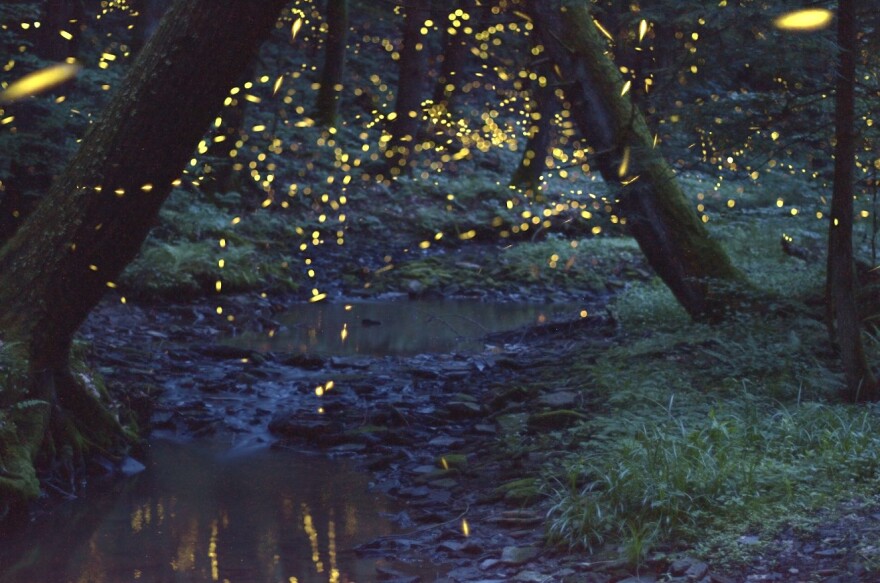Sarah Lower, an assistant professor of biology at Bucknell University, and student Susan Deering were catching fireflies on a recent afternoon at a farm in Kellettville, Pennsylvania, in Forest County.
But it wasn't just for fun. They're studying the insects, particularly the ones that don't light up as adults. Instead researchers believe they emit pheromones and use smell to communicate.
“This is a day-active firefly called lucidota atra. And they light up when they are in the larval stage, but not in the adult stage," Lower explained.
She provided a lesson in firefly anatomy — including how to tell the difference between a male and a female: “His antennae are like superlong and luscious.”

Lower was a graduate student and part of a team of researchers that visited the area in 2012. They were trying to find out if the flashing going on was in fact photinus carolinus. And it turns out, it was.
“This is a species that's really well known from the Smoky Mountains, because they have this huge summer emergence," Lower said. "They all come together in the forest and actually synchronize their flashes.”
Now those fireflies — including synchronous ones — are the stars of the Pennsylvania Firefly Festival at the farm Peggy and Ken Butler have in Kellettville, Forest County, drawing both firefly fans and researchers looking to learn more about the bugs.
Lower said there are a few hypotheses about why the males synchronize. One is that the females reply to the males when they take a break. That way the males can see the female response.
"There's some ideas that it might be what we call a 'lek' in biology. And that's when a bunch of individuals come together in one area, and are attracting members of the opposite sex," she said. "This is like, the 'it' bar, or the happening scene of the firefly land. So there's some competing hypotheses."
Butler, secretary of the Pennsylvania Firefly Festival, said after those scientists confirmed the synchronous firefly was there in 2012, they decided to put on a festival.
“We thought it might be a good idea to celebrate that firefly because Pennsylvania's state insect is a firefly," she said.
That festival grew over time, drawing people from all over.
“And eventually it got to the point where we had 1,000 people in one night to come see these fireflies," Butler said. "And we knew that we had an issue because there is such a thing as loving something too much.”

Now, Butler said, it’s a smaller educational event. They use a lottery system to have about 50 people a night and take steps to not disturb the fireflies.
“The life cycle is all on the ground. The only thing that's flying around in the air are the male fireflies showing off to the females. So everything is on the ground," she said. "So when we're walking through this habitat, we could be stepping on the next generation of fireflies. It takes a firefly about two years to go from egg to adult insect.”
Butler said the synchronous fireflies like it to be warm and muggy in the forest, and the weather on the Friday night of the festival is perfect. Before sitting down to watch the synchronous fireflies, everyone at the festival breaks up into smaller groups to take a short walk to see them.
Kathy Barclay, from Somerset, took it upon herself to serve as a crossing guard to protect one of the fireflies glowing from the ground.
“I’m guarding it … there’s one between my feet."
Barclay said she loves watching the fireflies at home.
“That’s one of my favorite nighttime activities is to just sit on the deck," she said. "But we don’t have the synchronous. So we really came here tonight to see the synchronous fireflies.”
After a walk back and into the woods, it’s about 10:30 p.m., and the synchronous ones have started. Visitors put their chairs along the path on the edge of the woods to see the light show.
Ken Butler said the synchronous fireflies are like a wave at a stadium.
“Here, this group typically the leader starts from left to right," he explained as the fireflies blinked. "If you watch this, they’re really synchronizing now the whole length. So they’re starting down here and they all go dark … like that … and then you look to your left and you’ll start to see the blinking start down here, and then it just sort of works its way up and then it keeps going like a wave.”
Mary Sweeney, from Oil City, was there with her friend and neighbor.
“I’ve seen fireflies my whole life, but this, I will probably never see again,” she said from her lawn chair.
There are more than 2,000 species of firefly in the world, including about 170 in the United States and Canada.
While the fireflies in Pennsylvania will be done with mating season soon, the research and opportunities to support that work continue. Citizen scientists can collect data for the Firefly Atlas, which scientists use in their research.
Kristy Gallo, a Bellefonte resident and ambassador with the Xerces Society for Invertebrate Conservation, said there are simple steps people can take to help fireflies thrive — like turning unneeded outdoor lights off or switching to motion detecting lights.
With outdoor light pollution, she said, "These females they might think, 'Yeah, not tonight,' if there's too much light, and they can't really see the courtship dance above," she said. "And then we can see that population dwindle and disappear from that area."
"The smallest steps can be really significant," Gallo said.



